Home » Who We Serve » Stair Manufacturers
Best Lighting Systems for Stair Manufacturers: Innovative and Efficient Solutions
The polarizing popularity and versatility of LED lighting has revolutionized many industries and gave rise to new lighting solutions that were very challenging to execute or never possible with traditional lighting sources. Stair lighting makes no exception. To make stair lighting more accessible to the masses we have developed a good selection of LED lighting products that fit a variety of stair lighting applications. Being specialists in custom LED lighting and lighting controls we work with stair manufacturers through all phases of a project from design to manufacturing and we manufacture and supply robust lighting systems that meet your customers’ exact specifications.
Stair lighting systems can become very complex, especially when lighting controls are involved. We take pride in offering great warranties and a headache-free experience. We stand behind our products and you will never have to worry about compatibility issues between the electrical components of stair lighting systems. We manufacture and deliver LED lighting systems directly to you or your job-site complete, pre-wired and ready for installation.
Lighting for Stairs: A Blend of Safety and Elegance
- There are many ways a staircase can be lit and selecting the right one may be a daunting task.
Not only are there a slew of technical considerations/constraints that should be taken into
account, but the selected type of lighting should be in harmony from an architectural design
standpoint with the rest of the lighting and design elements of the ecosystem that the staircase
is part of. A couple of examples of such design considerations include the correlated colour
temperature (CCT) of the light and the style and installation of the luminaires. - Stair lighting should not cause any glare or discomfort, as it can easily become a safety concern
for those climbing up or down the stairs. Discomfort may be caused by lighting that is too bright
or LED tape that is not properly installed inside an aluminum housing that comes with a diffuser.
Discomfort may also be caused by LED lighting that is improperly installed directly pointing
towards the eyelevel of those climbing up the stairs – this is very common for linear LED
treadlights that do not use an angled housing such as the one presented in the figures below
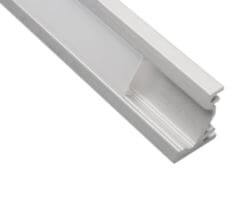
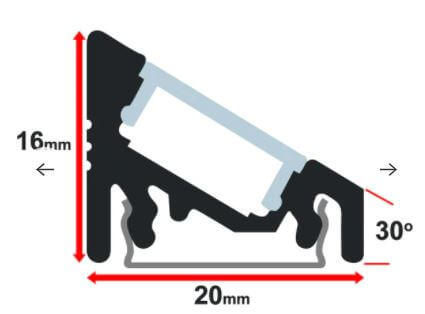
- Lighting controls play a critical role in the functionality and appeal of any lighting system and stair lighting systems make no exception. Motion-control from multiple points is a very common feature in LED stair lighting where the lighting system dims up or turns on when motion is detected and it dims back down or turns off when motion has ceased. Equipping your stairs with lighting that is dimmable and/or on a timer also help tune the lighting to the user’s requirements and optimize the consumption of energy. Dimming in particular should be considered where the staircase is installed in spaces where additional sources of light are present such as natural light received through the windows.
- Opting for professional installation is highly important to ensure the lighting is appropriately installed and all wiring is safely routed and concealed inside the stairs and/or walls. Depending on the type of stair lighting selected there may be various wiring options available, but regardless of what option you choose our recommendation is for the installation and connections to be done by a certified electrician.
As a stair lighting manufacturer we work directly with stair manufacturers and their clients to design custom lighting systems with consideration to all of these important aspects. We will make sure that the stair lighting systems manufactured are designed for optimal installation into the specific application of your customers, whether the installation takes place on site for pre-installed stairs or off site for new stair cases that have not been delivered and installed.
Residential Lighting Systems: Elevating Staircase Aesthetics
Residential stair lighting systems improve the aesthetics of any home by providing an ambient light and adding a modern yet classy touch. Stair lighting does not only contribute to the safety of those using the stairs by lighting their climbing path, but it also helps emphasize the finish of the staircase. By lighting the treads of the staircase the grain (for wooden steps), texture and colour of each step will be highlighted giving the staircase a sleek look.
When it comes to residential stair lighting systems there are several common types available to choose from:
Linear treadlights – this is one of the most popular types of stair lighting that is compatible with a variety of staircase designs such as open riser, closed riser, floating or mono-beam installation. Linear LED treadlights install in a groove at the bottom of the tread into the nosing and they are intended to project the light onto the step below. The wiring can be routed through one of the adjacent side-walls, the inside of the staircase for closed riser design or a mono-beam if present. Linear treadlights are also suitable for surface retrofit installations, however, for such applications we recommend using a very thin aluminum housing with continuous LED tape.
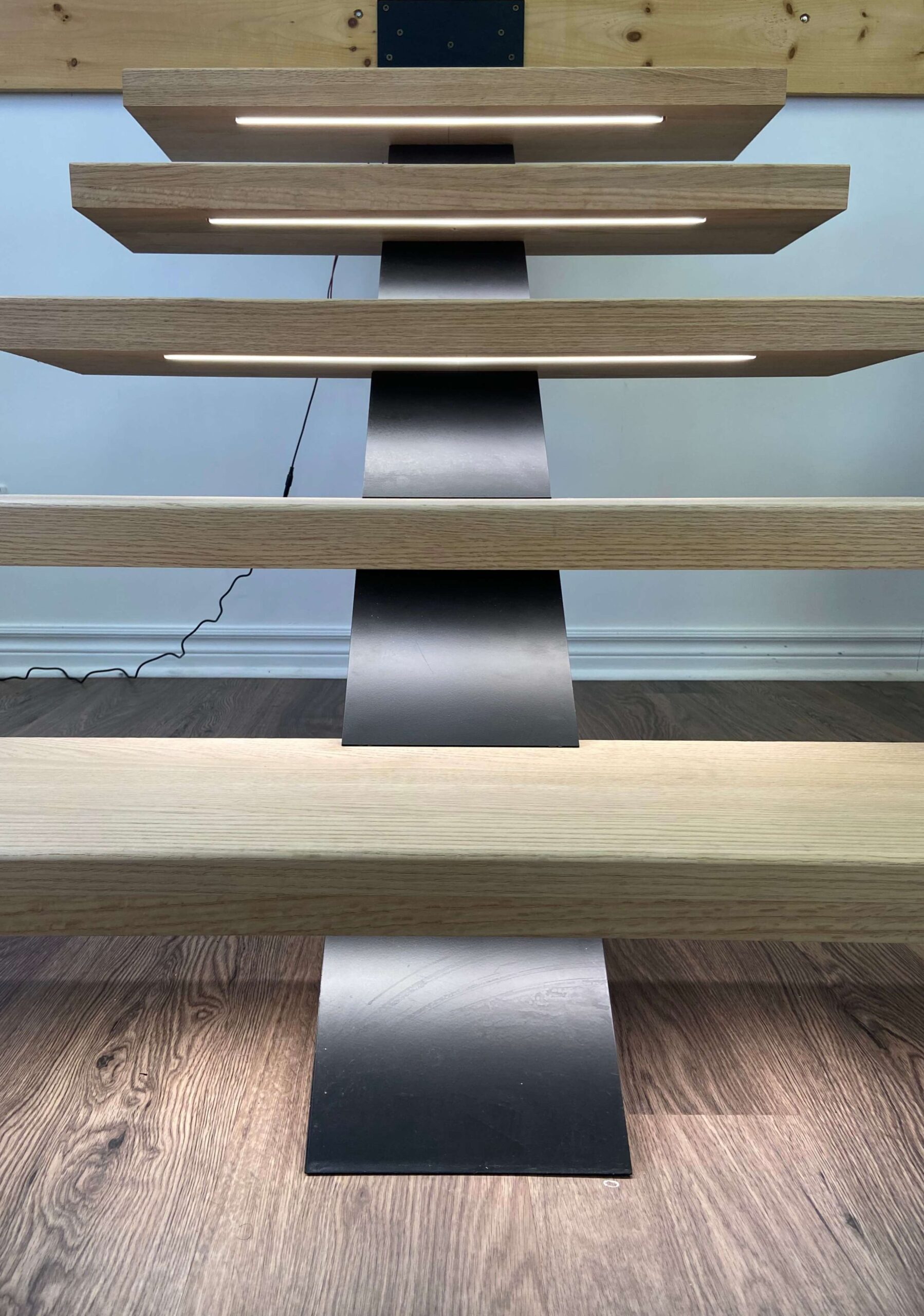
Center-beam lighting – for those stair cases supported by a mono-beam, the stair lighting luminaires can be installed recessed in the front wall of the support beam. Depending on whether the front wall of the support beam is angled or perpendicular to the floor, consider using a luminaire housing design that shoots the light downward in an angle towards the step below it. When it comes to wiring most center beams are made of metal and are hollow inside, allowing for the wiring of the lighting system to be safely routed through the inside of the mono-beam.
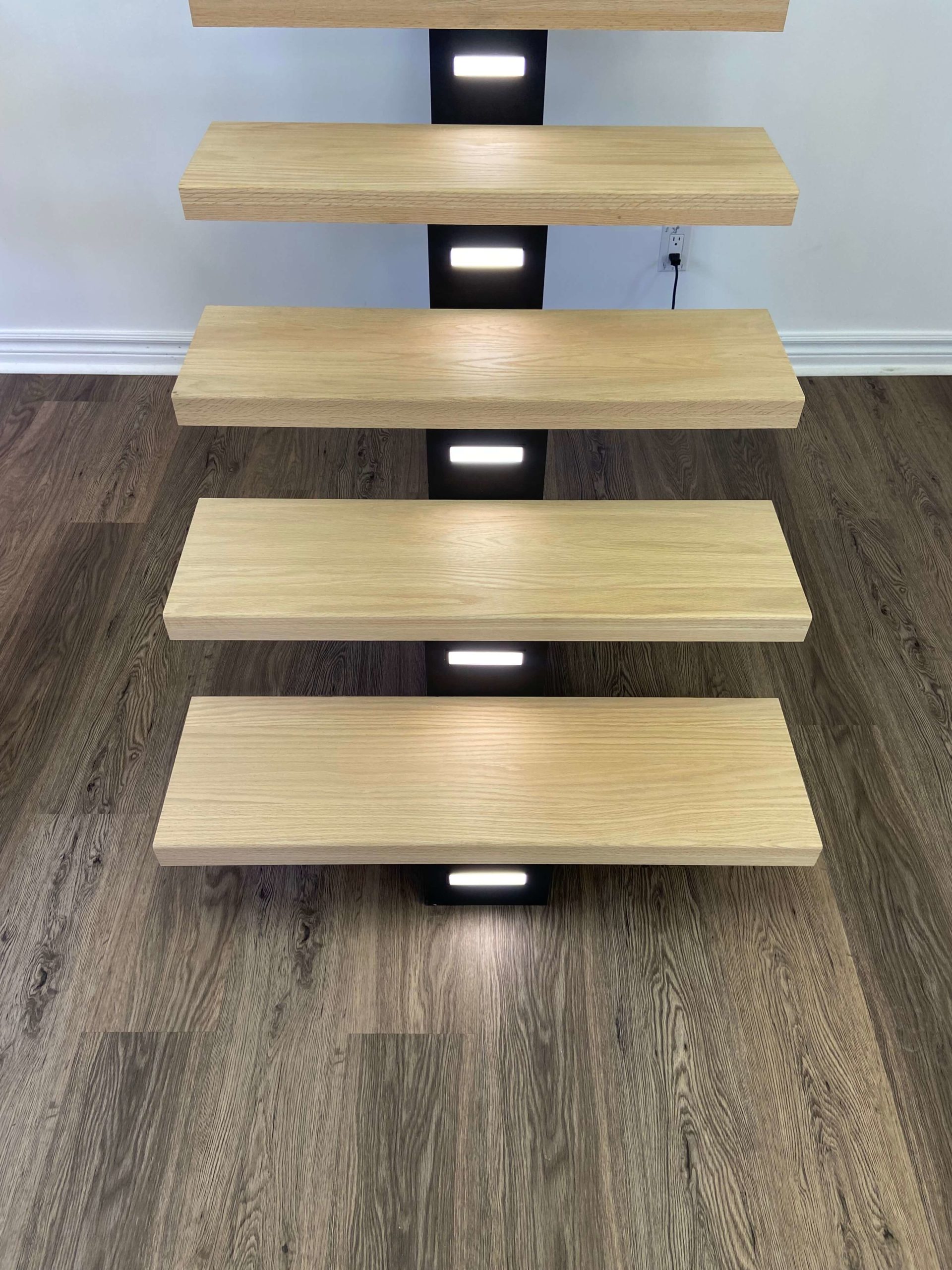
Illuminated handrails – another common type of lighting that is appropriate for a variety of applications where a handrail is present. The LED lighting can be installed in a groove inside an aluminum housing that is recessed into the bottom of the handrail. The wiring can be routed through special hollow brackets that hold the handrail and into the adjacent sidewall. While versatile and appropriate for retrofit installations illuminated handrails are not ideal for applications where a glass railing is present due to the glare they may cause.
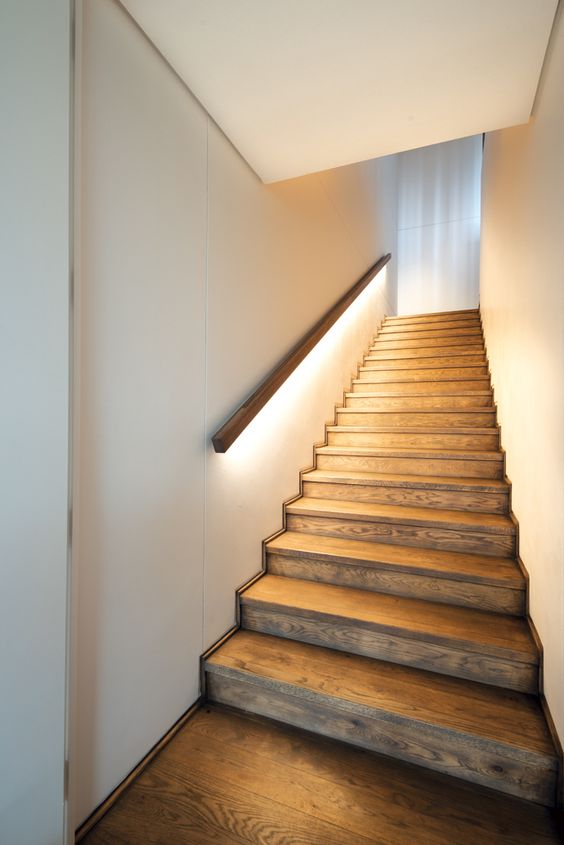
Sidewall luminaires – a great lighting option when the staircase has a sidewall and the customer does not want to make alterations to the stairs themselves. There are many luminaire designs available from recessed models to surface installed luminaires and sconces. Sidewall lighting requires wiring through the inside of the wall and is not suitable for staircases with glass railings. With proper consideration to the lumen output of the luminaires and their light distribution, sidewall luminaires don’t have to be installed above each step. Depending on their distance from the steps of the stairs, one luminaire can provide light for several steps.

Ceiling lighting – this is the least “invasive” type of stair lighting and does not require any alterations to the stairs themselves or the sidewalls. Ceiling lighting is appropriate as long as the stairs are not in a widely open space where the ceiling is too far above the stairs. Important considerations include the installation of sufficient lighting fixtures to cover the entire length of the staircase and landings. Suitable lighting options include gimbal pot-lights with a narrower lighting angle that can be adjusted and directed towards the stairs, track lighting with multiple adjustable heads or even chandeliers.
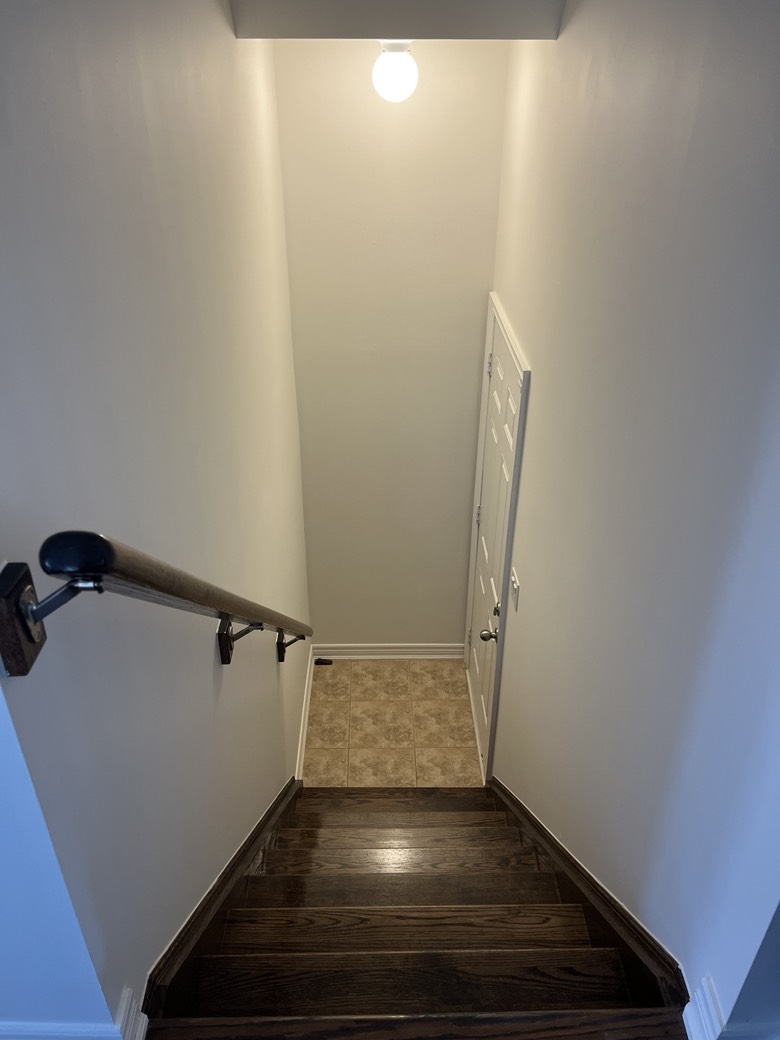
Outdoor Lighting Systems: Enhancing Stair Safety and Appeal
Stair lighting is also very popular outdoors and plays a key role in landscaping and architectural design. Outdoor stair lighting significantly increases safety as outdoor spaces are more prone to darkness outside of daylight hours than indoor spaces due to less artificial lighting sources typically available. Outdoor spaces are also exposed to the elements and there are more tripping hazards than indoors due to vegetation and exposure to the elements. Unless they are heated, outdoor stairs are likely to freeze during the winter months and can become slippery. Outdoor stair lighting can increase visibility and help reduce the risk of slip and fall accidents.
The types of stairs typically found outdoors have a closed riser and are made of stronger materials such as brick, concrete, marble, ceramics, or rock. There are also open riser stairs usually found on wooden decks, while non-glass side-walls or mono-beams are rarely present. Consequently the selection of suitable LED stair lighting is much narrower and it is more difficult to retrofit a lighting system due to the wiring constraints presented by harder materials and the absence of sidewalls. Most commonly, outdoor lighting systems are contemplated into the design of the architectural and landscaping elements of the outdoor space from the planning phases of the project.
Another important consideration is that all electrical components used in outdoor LED lighting systems including the LED lighting itself should be outdoor rated in order to resist the elements. With that said, there are several common types of LED lighting for outdoor stairs:
Illuminated handrails – probably the most common type of lighting when handrails are present.

Sidewall luminaires – most commonly found on stairs that have a sidewall. They can also be surface installed on the newels of rails or decks. For recessed installation sidewall luminaires most often need to be contemplated into the design of the stairs from the build stage and are difficult to retrofit into harder materials such as brick or concrete. They can, however, be surface installed with the wiring routed through the ground.

Illuminated newels – a popular option where handrails and decks are present and the newels come prefabricated with an LED light source inside.

Photovoltaic (Solar) outdoor lighting – the most cost-effective lighting solution that can be purchased off the shelf at most home décor and hardware stores. The light provided, however, typically has a lower lumen output and is not as effective as hardwired LED lighting systems in improving safety.
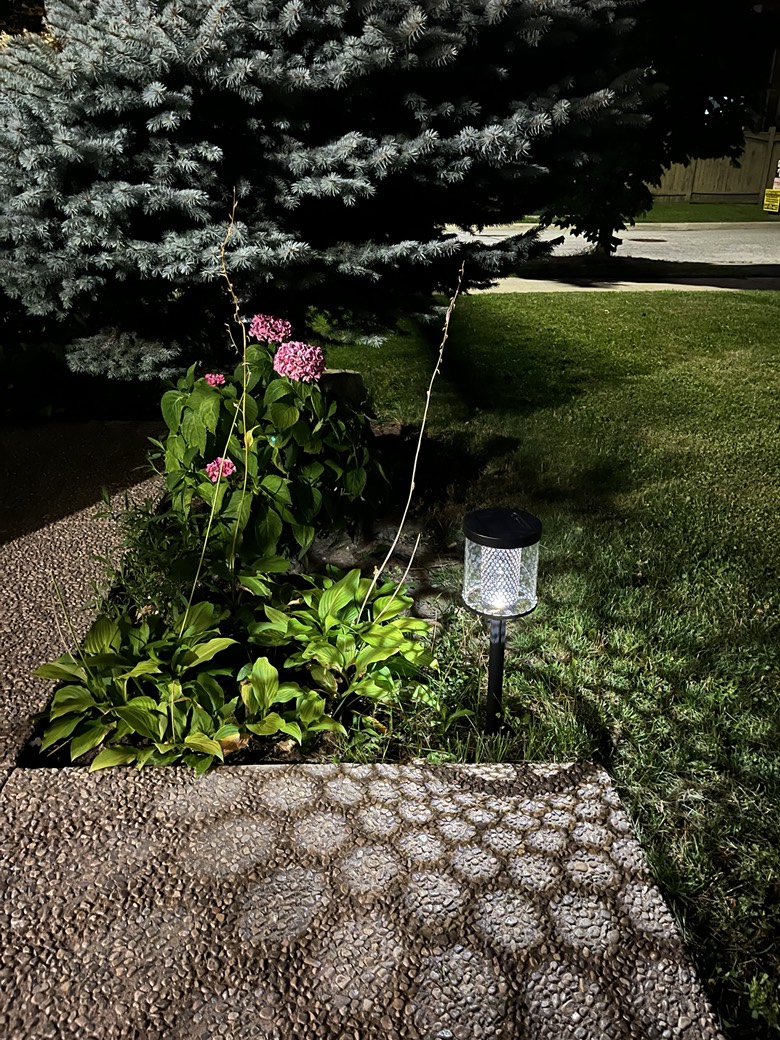
Commercial Stairwell Lighting: Balancing Functionality and Design
Commercial stairwell lighting plays a key role in enhancing safety and reducing the risk of injury from slip and fall accidents in high-traffic areas. Stair lighting consequently helps reduce liability to the business and with proper lighting controls and automation such as motion sensors and timers it can be very effective in maintaining the cost of energy consumption low. In considering stair lighting for your commercial clients, it is important to remember that in commercial applications lighting systems typically operate for longer periods of time than in residential applications. Consequently, using high-quality and durable components becomes very important in maintaining your clients’ satisfaction.
When it comes to the most common types of stairwell lighting found in commercial applications, the same options are available as for residential applications. The best choice comes down to the design of the stairs, the materials used, the use of the stairs and your client’s preference. Commercial and industrial buildings typically employ higher strength materials on stairs such as concrete with mosaic finishes, marble, ceramics or even metal. This narrows down slightly the selection of suitable LED lighting systems and installation options but we can help you navigate these challenges and suggest the most appropriate lighting system for any application.
Intelligent Stair Lighting Systems: Smart Integration for Modern Homes and Offices
LEDs gave rise to better technology around lighting controls and automations and enabled certain applications that were never possible before. Smart lighting features such as automation, remote control, and integration of your client’s stair lighting system with other smart home systems are very popular with LED’s for enhanced energy management and comfort. Motion sensors, dimmers and timers, while still popular with incandescent traditional lighting, are much more popular with LED lighting due to significantly less compatibility challenges and a more seamless integration. Intelligent stair lighting systems help enhance safety and further reduce the risk of injury for people and pets. At Diana Lighting and Controls we specialize in lighting controls and automation and all of our LED stair lighting systems are compatible with and can be integrated with Smart Home and Office management systems and applications.
We specialize in working with stair manufacturers and have developed great relationships in the Greater Toronto Area based on our professionalism and great technical knowledge. At Diana Lighting and Controls we manufacture custom LED lighting systems suitable for indoor and outdoor use in residential and commercial stair applications. For any questions or inquiries about stair lighting contact Lawrence at (647) 202-9126.
FAQs
What makes Diana Lighting's LED solutions unique?
Our LED lighting solutions are appropriately designed to fit our customers’ exact needs. We do not take a “one-size-fits-all” approach. We sit down with our customers to understand the intended purpose of the lighting and only offer right-sized practical solutions. We never sell more light than our customers need and we never sell product features that our customers don’t need. We understand the importance of remaining cost effective and strive to provide only the right lighting solutions leveraging the depth of our expertise in the lighting industry.
How do I choose the right lighting for my space?
To determine the right lighting for any space the first step is to define the functionality of that space. The type of activities performed during the space and their timing throughout the day are key factors that need to be accounted for. Second, the location of the space relative to natural sources of light and the amount of natural light that is allowed in that space also play a critical role. Our team at Diana Lighting can guide you through the process and advise on the right lighting for your space, including ideal amount in lumens, colour temperature and location of the lighting sources.
What is the best lighting for a Business Office?
Natural light always provides the best lighting for a business office. To complement natural light sources we recommend installing lighting that comes with a colour temperate of 4000K or as close as possible to that. Daylight harvesting control is also a great feature to have in business office spaces as it allows for a constant level of illumination to be maintained throughout the day while attaining significant cost savings over time.
How do you reduce glare in the office lighting?
There are three methods we recommend to reduce glare in the office lighting:
- Use as much indirect lighting as possible
- Apply glare reduction film on your windows
- Use task lighting to light up areas like desks, countertops or other places where work gets done
What is the best lighting for computer work?
Computers emit a good amount of light from their screens. For this reason, there isn’t a lot lighting required in spaces where computer work takes place. We recommend two types of lighting for computer work:
- Indirect lighting such as cove lighting that is not directly aimed on the workstations
- Task lighting that is aimed at those areas where the light emitted by screens cannot effectively reach, such as desk surfaces or keyboard level
What is the best lighting for productivity?
The best lighting for productivity depends on the specific use of the space being lit.
- For offices we recommend natural light. To complement natural light sources we recommend installing lighting that comes with a colour temperate of 4000K or as close as possible to that.
- For industrial spaces where production takes place we recommend two types of lighting: general ambient lighting in an amount that is sufficient to prevent accidents, complemented by task lighting aimed directly at those areas where work takes place such as the controls of a machine or a conveyor belt.
